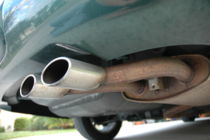


automobile emissions control
From Wikipedia, the free encyclopedia
Automobile emissions control covers all the technologies that are employed to reduce the air pollution-causing emissions produced by automobiles. Exhaust emissions control systems were first required on 1966 model year vehicles produced for sale in the state of California, followed by the United States as a whole in model year 1968. Their use became widespread in the following decades and now they are ubiquitous in industrialised nations and common in most others.
Emissions controls have been highly successful in reducing the emissions produced by motor vehicles in terms of quantity per distance traveled. However, substantial increases in the distance traveled by each vehicle, and equally substantial increases in the number of vehicles in use, have meant that the overall reduction in pollution has been much slower.
The emissions produced by a vehicle fall into three basic categories:
- Tailpipe emissions:
This is what most people think of when they think of vehicle air pollution;
the products of burning fuel in the vehicle's engine,
emitted from the vehicle's exhaust system. The major pollutants emitted
include:
- Hydrocarbons: this class is made up of unburned or partially burned fuel, and is a major contributor to urban smog, as well as being toxic. They can cause liver damage and even cancer.
- Nitrogen oxides (NOx): These are generated when nitrogen in the air reacts with oxygen under the high temperature and pressure conditions inside the engine. NOx emissions contribute to both smog and acid rain.
- Carbon monoxide (CO): a product of incomplete combustion, carbon monoxide reduces the blood's ability to carry oxygen and is dangerous to people with heart disease.
- Carbon dioxide (CO2): although this is a product of the complete combustion of hydrocarbons, is plentiful in the atmosphere, has no immediate harmful effects to humans and is essential to plant life, emissions of carbon dioxide are considered a pollutant because it is a significant greenhouse gas and increasing its levels in the atmosphere is thought by many to be a contributor to global warming.
- Evaporative emissions: These are produced from the evaporation of
fuel, and are a large contributor to urban smog, since these heavier
molecules stay closer to ground level. Fuel tends to evaporate in these ways:
- Gas tank venting: the heating of the vehicle as the temperature rises from the night-time temperature to the hottest temperatures of the day mean that gasoline in the tank evaporates, increasing the pressure inside the tank above atmospheric pressure. This pressure must be relieved, and before emissions control it was simply vented into the atmosphere.
- Running losses: the escape of gasoline vapors from the hot engine.
- Refuelling losses: these can cause a lot of hydrocarbon vapor emission. The empty space inside a vehicle's tank is filled with hydrocarbon gases, and as the tank is filled, these gases are forced out into the atmosphere. In addition, there is loss from further evaporation and fuel spillage.
- Life cycle emissions: These are produced in activities associated
with the manufacturing, maintenance, and disposal of the automobile and
include such items as:
- Manufacturing plant power requirements
- Volatile solvents utilized in the manufacturing process (auto paint finishes, etc)
- Outgassing of synthetic materials utilized to reduce weight and simplify manufacturing
- Maintenance requirements such as oil and filter changes, battery replacement, etc.
- Disposal requirements including contaminated lubricants, tires, heavy metals, and landfill
Contents |
[edit] Tailpipe emissions control
Tailpipe emissions control can be categorised into three parts:
- Increasing engine efficiency
- Increasing vehicle efficiency
- Cleaning up the emissions
[edit] Increasing engine efficiency
Engine efficiency has been gradually improved with progress in following technologies:
[edit] Increasing vehicle efficiency
Contributions to the goal of reducing fuel consumption and related emissions come from
- lightweight vehicle design
- minimized air resistance
- reduced rolling resistance
- improved powertrain efficiency
- increasing spark to the spark plug (this topic should be under the ignition system)
Each of these items breaks down into a number of factors.
[edit] Increasing driving efficiency
Significant reduction of emissions come from
- driving technique (some 10-30% reduction)
- unobstructed traffic conditions
- cruising at an optimum speed for the vehicle
- reducing the number of cold starts
[edit] Cleaning up the emissions
Advances in engine and vehicle technology continually reduce the amount of pollutants generated, but this is generally considered insufficient to meet emissions goals. Therefore, technologies to react with and clean up the remaining emissions have long been an essential part of emissions control.
[edit] Air injection
A very early emissions control system, the Air injection reactor (AIR) reduces the products of incomplete combustion (hydrocarbons and carbon monoxide) by injecting fresh air into the exhaust manifolds of the engine. In the presence of this oxygen-laden air, further combustion occurs in the manifold and exhaust pipe. Generally the air is delivered through an engine-driven 'smog pump' and air tubing to the manifolds. This technology was introduced in 1966 in California, and was in use for the next several decades. It is not generally in use any longer, having been supplanted by cleaner burning engines and better catalytic converters.
[edit] Exhaust Gas Recirculation
Engines produced after the 1973 model year have an exhaust gas recirculation valve on the intake manifold; its sole purpose is to reduce NOx emissions by introducing exhaust gases into the fuel mixture, lowering peak combustion temperatures.
Around 1990, the Jeep division's powerplants (2.5 and 4.0) eliminated the EGR system. Some other engines also have dispensed with EGR, such as GM's Ecotec engine which was able to meet LEV emissions standards without requiring EGR. In some cases, the valve timing has been set to hold some exhaust in the combustion chamber after the exhaust stroke to perform a similar function to EGR.
[edit] Catalytic converters
The catalytic converter is a device, placed in the exhaust pipe, which converts various emissions into less harmful ones using, generally, a combination of platinum, palladium and rhodium as catalysts. Catalytic converters have been steadily improved over the years. They make for a significant, and easily applied, method for reducing tailpipe emissions. Their other significant effect on pollution was that they were incompatible with the use of tetraethyl lead as an octane booster in gasoline, prompting the phasing-out of that additive as converter-fitted cars became more prevalent. The lead emissions were highly damaging to human health, and its virtual elimination has been one of the most successful reductions in air pollution.
[edit] Evaporative emissions control
Efforts at the reduction of evaporative emissions include the capturing of vented vapors from within the vehicle, and the reduction of refuelling emissions.
[edit] Capturing vented vapors
Within the vehicle, vapors from the fuel tank are channelled through canisters containing activated carbon instead of being vented to the atmosphere. The vapors are adsorbed within the canister, which feeds into the inlet manifold of the engine. When the vehicle is running, the vapors desorb from the carbon, are drawn into the engine and burned.
Evaporative emissions from the vehicle are limited by law and tested as part of the new vehicle type approval by a so-called SHED-test. The current limit is 2 grams of HC per hour, which may amount to an evaporation of one liter (1/4 gallon) in a month.
[edit] Reducing refuelling losses
All modern vehicles have tank filler necks that instead of just being a tube into the tank, as in earlier vehicles, now have a small-diameter hinged and spring-loaded door only large enough for the tip of the filler nozzle. This prevents vapor leakage when the filler cap is removed, and also prevents a catalytic converter-fitted vehicle being refuelled with leaded fuel (since the leaded fuel nozzle is too large to fit).
This is accompanied by modifications to the filling station pumps. They are now equipped to suck the vapors back into the pump as they are displaced by fuel. Some have intakes around the head of the filler nozzle, while others have a rubber 'boot' that presses securely around the end of the filler neck to prevent vapors escaping.
Vehicles sold in North America started to be equipped with "onboard refueling vapor recovery" (ORVR) systems around 1997. These systems are designed to capture the vapors displaced by the incoming fuel and evaporated by high evironmental temperatures in the vehicle's vapor canister rather than releasing them into the atmosphere. This system makes vapor recovery systems on filling station pumps redundant.
[edit] Emission Testing
In 1966, the first emission test cycle was enacted in the State of California measuring tailpipe emissions in PPM (parts per million). The most common test used until the 1980s was the idle test (usually a two-speed idle test), later to be succeeded with a dynamometer (the latest variant is known as the accelerated simulated mode, ASM for short).
ASM testing tests for three gases instead of two; if one gas emission is higher, the vehicle fails the test. Usually, vehicles under 8500 GVW and gasoline powered are subjected to ASM testing with the exemption of all-wheel drive vehicles (including full-time four wheel drive). The Environmental Working Group used California ASM emissions data to create an Auto Asthma Index that rates vehicle models based on emissions of hydrocarbons and nitrogen oxides, the chemicals that create smog.[1]
Some cities are also using a technology developed by Donald H. Stedman, PhD. (a chemistry professor at the University of Denver) which uses lasers to detect emissions while vehicles pass by on public roads, thus eliminating the need for owners to go to a test center. Stedman's laser detection of exhaust gases is the progenitor of remote sensing devices - commonly used in metropolitan areas.
By the early 1990s after the passage of the Clean Air Act of 1990, stricter testing criteria was phased in; the EPA introduced the IM240 testing. Around 35 states (as of this writing) have phased in I/M (inspection/maintenance) criteria modeled after the California Air Resources Board's emission testing standard.
California emission testing laws were amended in 1998 when SB 42 was passed - a new criteria phased in was the rolling chassis exemption to which vehicle manufactured between 1973 - 1998 were subjected to emission testing. This law was reversed last year by California governor Arnold Schwarznegger where the rolling chassis exemption was repealed; as of 2005, 1976 and newer vehicles are subject to testing.
[edit] References
- Schwartz, Joel (2003) No Way Back: Why Air Pollution Will Continue to Decline AEI Press, Washington, D.C.



